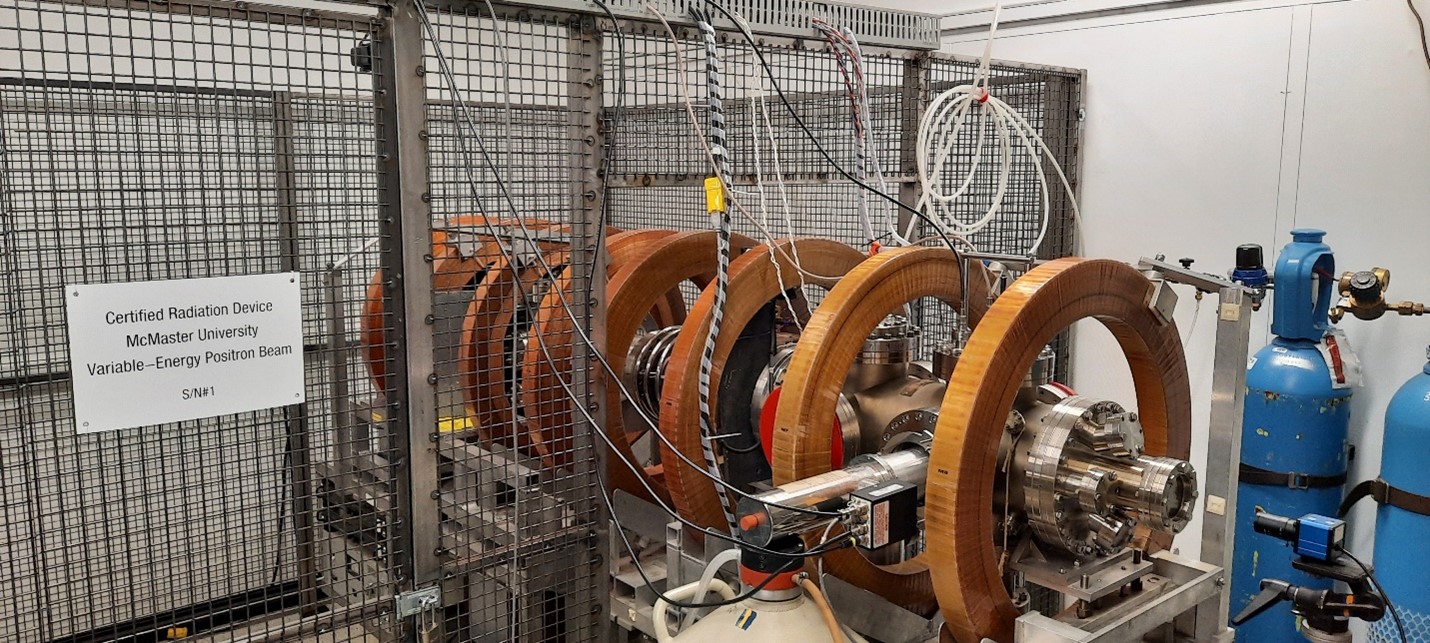McMaster launches new era of positron beam science with installation of beamline

A collaboration led by engineering physics professors Peter Mascher (William Sinclair Chair in Optoelectronics) and Andy Knights (Associate Vice-President, Research) is ushering in a new era of positron beam science at McMaster University.
The research team, which includes post-doctoral fellow Dr. James Gaudet, has successfully established a positron beamline that will be used to characterize materials at the nano-scale. This unique-in-Canada facility is an essential tool for developing next-generation semiconductors, photonics, and advanced communications technologies.
“There are perhaps only a dozen positron beams for materials research worldwide, so this facility is an important milestone for both McMaster and Canada,” notes Andy Knights.
First proposed by Paul Dirac in 1931, and then observed experimentally by American physicist Carl Anderson in 1932, positrons are the anti-matter counterpart to electrons. Since the 1960s, Canadian scientists have played a major role in the development of positron science, with research groups at McMaster, Western, McGill, Queens, Dalhousie, Winnipeg and Guelph making important contributions to the field. At McMaster, Physics & Astronomy professor Jules Carbotte (d. 2019) was a significant pioneer. A leading scholar in condensed matter theory, Carbotte explored the process of positron annihilation in metals to help scientists better understand how positrons interact with solid objects.
McMaster’s new positron beamline – repurposed from Professor Peter Simpson’s research laboratory at Western University – contains a source of the radioisotope sodium-22 (Na-22), which releases positrons as it undergoes radioactive decay. The positrons are moderated, then accelerated through a beam-tube using a series of high-voltage magnetic coils. Next, the positrons are directed onto a sample where they undergo a process called “annihilation” – each positron interacts with an electron and the two produce gamma radiation, which is measured by a high-purity germanium detector.
Researchers then analyze the size and shape of the detector signal to extract information about the momentum of the annihilating electron/positron pair. This information can be used to determine nano-scale properties such as the size and concentration of atomic-scale lattice defects and their chemical environment. By adjusting the accelerating potential of the positron beam, users can create depth profiles of defects and microstructures within their samples.
The new beamline will be an invaluable resource for characterizing innovative new materials that will fuel innovations in medicine, science, and energy technology. Peter Mascher says that it will be used not only by research groups at McMaster, such as those at the Brockhouse Institute for Materials Research and the Centre for Emerging Device Technologies, but by researchers from across Canada and the world.
“Canadian researchers have played a fundamental and critical role in the development of positron annihilation as a unique tool for materials research. The new positron facilities at McMaster will allow us to build on this legacy and create a hub for positron-enabled research for the global community,” says Mascher.
What’s next for positron science at McMaster? Two key initiatives are in the works. First, a new high-activity Na-22 source has recently arrived from Cape Town, South Africa, and will replace the legacy source that’s currently in use. The greater amount of Na-22 will create a more intense positron beam that will increase the sensitivity of the current experimental set-up.
Second, the research team is working to install a complementary beamline at the McMaster Nuclear Reactor, using gamma rays from the reactor core to generate positrons. This facility will be one of only three reactor-based positron beams worldwide and will draw researchers from the international community once it is operational in Spring 2023.
These two initiatives will enable the legacy of positron science in Canada to continue.
“McMaster is uniquely placed to become a global centre of excellence in the study of materials with antimatter. It is incredibly exciting to imagine and develop new experimental techniques that will support nano-scale engineering and further enhance McMaster’s reputation in nuclear technology and materials science,” says Knights.
News